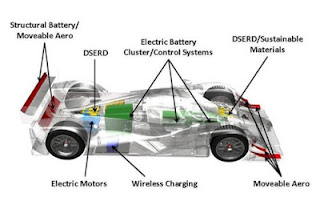The Lola-Drayson team have just revealed what is intended to be the fastest electric-powered racing car in the world. The B12/69EV is built on a current Lola LMP1 chassis with Drayson’s 4X2-640 drive train, that is claimed to propel the car at speeds up to 200 miles/hr and deliver more power than an equivalent gasoline powered car.
“Don’t judge electric cars by what you are seeing on the street right now,” says Lord Paul Drayson. He is one of many around the world intent on proving that electric vehicles do not have to be slow boring ugly golf carts. Drayson says that the partnership’s “main aim is to prove that an electric powered LMP car can lap as fast, if not faster than a conventionally powered car and to show how exciting an 850 horsepower, 200 mph plus electric car is on track.”
The B12/69EV is built on a standard race car chassis but with a number of advanced technologies.
First, this is an electrically powered race car. The four axial flux Oxford YASA motors generate over 850 peak horse power to the rear wheels. Off the starting line, the electric racer is claimed to zoom from zero to 60 mph (96.56 km/h) in 3 seconds, or zero to 100 mph (160.93 km/h) in 5.1 seconds.
The main battery pack is a new generation of Lithium Nanophosphate battery cells made exclusively by A123 Systems and used for the first time by Drayson’s car. The battery pack will provide enough range for 15 minutes of racing.
Another trick up their sleeve is to improve range by freeing the car’s main battery from ancillary tasks like headlights. This technology comes from BAE Systems’ closely guarded “structural battery” technology
 – which allows sections of carbon-fibre bodywork to supply power. “They are made out of honeycombs of carbon fibre filled with a solution that gives them the energy storage capacity of a battery,” says Julian Sole, chief designer at Lola Cars.
– which allows sections of carbon-fibre bodywork to supply power. “They are made out of honeycombs of carbon fibre filled with a solution that gives them the energy storage capacity of a battery,” says Julian Sole, chief designer at Lola Cars.
They’re also using technology from Multimatic of Rockingham, UK to harness the up-and-down motion of the car’s suspension to generate electricity on the move.
They’re also using Qualcomm’s Halo Inductive Power Transfer technology to charge the race car as it drives around the track. It uses two pads, one in the car and one embedded in the road surface, that together transfer power wirelessly to the car. The idea is to install a number of these pads around the track and the car will be able to pick up electrical charge as it drives around. Hopefully this means more than 15 minutes of race time.
They’re also using Qualcomm’s Halo Inductive Power Transfer technology to charge the race car as it drives around the track. It uses two pads, one in the car and one embedded in the road surface, that together transfer power wirelessly to the car. The idea is to install a number of these pads around the track and the car will be able to pick up electrical charge as it drives around. Hopefully this means more than 15 minutes of race time.
- Is there enough Grid Capacity for Hydrogen Fuel Cell or Battery Electric cars? - April 23, 2023
- Is Tesla finagling to grab federal NEVI dollars for Supercharger network? - November 15, 2022
- Tesla announces the North American Charging Standard charging connector - November 11, 2022
- Lightning Motorcycles adopts Silicon battery, 5 minute charge time gives 135 miles range - November 9, 2022
- Tesla Autopilot under US Dept of Transportation scrutiny - June 13, 2022
- Spectacular CNG bus fire misrepresented as EV bus fire - April 21, 2022
- Moldova, Ukraine, Georgia, Russia, and the European Energy Crisis - December 21, 2021
- Li-Bridge leading the USA across lithium battery chasm - October 29, 2021
- USA increasing domestic lithium battery research and manufacturing - October 28, 2021
- Electrify America building USA/Canada-wide EV charging network - October 27, 2021













